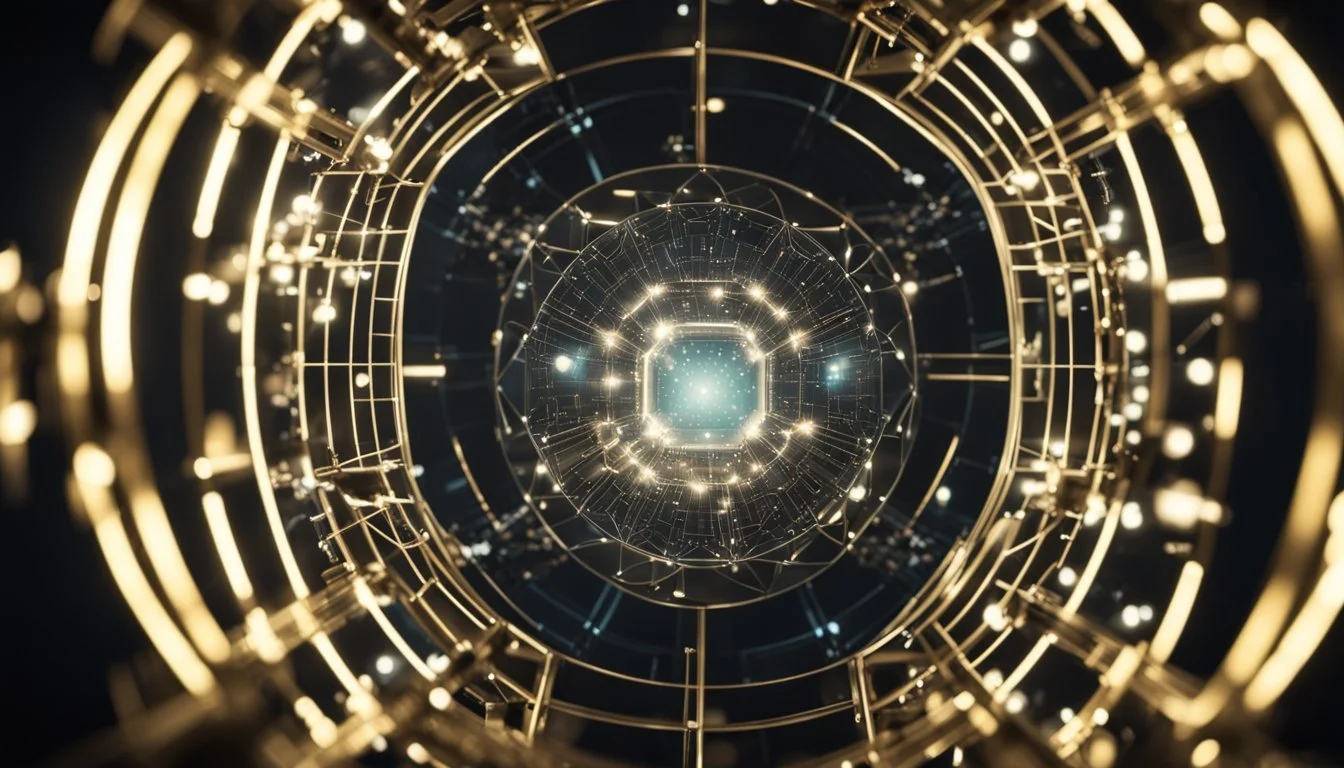Essential Documentaries on Quantum Physics
Exploring the Subatomic World
Quantum physics, a fundamental theory in physics, fundamentally challenges our understanding of the world at the most microscopic scales. This branch of science speaks to the behavior of matter and energy at the atomic and subatomic levels, revealing a reality that is vastly different from our everyday experiences. Documentaries on this subject aim to bridge the complex concepts of quantum mechanics with the curiosity and interest of the general audience, often utilizing compelling storytelling to elucidate the seemingly abstract phenomena that govern the universe.
These documentaries serve as a crucial medium for disseminating knowledge about quantum physics to a broader audience. They translate the intricacies of the subject into engaging narratives that capture the imagination and convey the significance of quantum discoveries. The focus of such films is not only on the scientific theories themselves but also on the profound implications these theories have on our perception of existence.
Through expert interviews, visualizations, and explanatory segments, viewers are guided through the enigmatic and often counterintuitive world of quantum mechanics. The films typically explore how this branch of physics has evolved over time, how it continues to influence technology, and how it intersects with philosophical questions about the nature of reality. The aim is to leave the viewer with a deeper appreciation of the universe's complexities and the fascinating ways in which quantum physics continues to expand the boundaries of human knowledge.
Into the Universe with Stephen Hawking
"Into the Universe with Stephen Hawking" is a documentary series that first aired in 2010. Narrated by the renowned theoretical physicist Stephen Hawking, the series presents complex ideas about the cosmos in an accessible manner. This three-part series explores various topics such as the nature of black holes, the possibility of alien life, and the origins and future of the universe.
The documentary is notable for its use of advanced computer graphics to illustrate scientific concepts. The visuals are accompanied by Hawking's insightful commentary, which has been praised for being thought-provoking while remaining understandable to non-experts.
Audience Reception Critics and audiences have lauded the series for making the wonders of the universe comprehensible without oversimplifying the science. The blend of entertainment and education is seen as a strong point of the series.
Educational Value Educators have recognized the series as a valuable tool for introducing students to advanced topics in physics and astronomy. The combination of Hawking's expertise and the high-quality visual effects provides a robust learning experience.
The series was produced by Discovery Channel and has been broadcasted on television networks around the world, enabling a global audience to explore the universe through Hawking's perspectives.
Particle Fever
Particle Fever is a documentary film released in 2013 that chronicles the first round of experiments at the Large Hadron Collider (LHC) near Geneva, Switzerland. Directed by physicist-turned-filmmaker Mark Levinson, the film captures the excitement and tension among physicists as they search for the elusive Higgs boson, a fundamental particle.
The documentary focuses on six scientists, each representing various aspects of the theoretical and experimental sides of particle physics. As the LHC powers up, they discuss the potential for monumental discoveries that could unlock the secrets of the universe, as well as the implications of not finding the Higgs boson.
Key Themes and Moments:
Expectations vs. Reality: Theoretical physicists' predictions compared to actual LHC results.
Personal Stories: The human element of scientific pursuit and the passion driving the researchers.
Scientific Milestones: The timeline of the LHC operations and key experiments leading to the Higgs boson discovery.
Impact on Science and Culture:
Particle Fever brings a complex topic to a wider audience, sparking interest in quantum physics.
The film shows the collaborative nature of scientific endeavors on a global scale.
The emphasis on the scientific method highlights the rigorous testing and analysis critical to experimental physics.
"Particle Fever" not only provides an inside look at one of the most significant scientific experiments of the 21st century but also humanizes the field, presenting the enthusiasm and dedication of the scientific community.
Faster Than the Speed of Light?
The concept of travelling faster than the speed of light is a tantalizing topic in modern physics. It challenges the fundamental laws as defined by Einstein's theory of relativity. The documentaries that explore this notion address various theories and propositions by physicists.
Special Relativity, a principle set forth by Albert Einstein, asserts that the speed of light is the ultimate speed limit of the cosmos. The documentaries often highlight that surpassing the speed of light could potentially allow for time travel or instantaneous movement across vast cosmic distances.
However, contemporary research introduces hypothetical particles known as tachyons. They are theorized to travel faster than light; yet their existence remains unproven due to the current lack of empirical evidence.
Quantum physics documentaries may explore the Alcubierre Drive, a speculative idea based on general relativity. It suggests the possibility of warping space-time to travel faster than light without violating relativity. This is often depicted through visual simulations.
Challenges: To date, faster-than-light travel has not been experimentally observed and remains a speculative area of physics.
Communicating Science: These documentaries strive to convey complex concepts in an accessible manner, utilizing animations and expert interviews.
By examining advanced theories and experimental research, these documentaries provide viewers with insights into one of the most intriguing questions in physics: Is it possible to travel faster than the speed of light?
The End of Quantum Reality
The End of Quantum Reality is a thought-provoking documentary that underscores the fundamental questions posed by quantum mechanics to our understanding of reality. Directed by Katheryne Thomas, it features the renowned philosopher of science, Dr. Wolfgang Smith, as he tackles the intricate world of quantum physics and its implications on the nature of reality.
Elements examined in the documentary include:
Quantum Mechanics: The documentary explains the basics of quantum mechanics and its counterintuitive principles, which have confounded scientists since its inception.
Wave-Particle Duality: A key concept of quantum theory that asserts particles can exhibit both wave-like and particle-like properties.
The film explores the potential philosophical and theological implications arising from quantum theory, discussing topics such as:
Perennial Philosophy: The documentary suggests a perspective where ancient philosophical wisdom and cutting-edge quantum physics intersect.
Materialism: It challenges the materialist worldview, suggesting that the universe might be composed of more than just measurable matter.
Dr. Smith's arguments aim to bridge the perceived chasm between science and spirituality, encouraging viewers to consider:
Consciousness: The role of the observer in quantum measurements, suggesting consciousness might be fundamental to reality.
Purpose: The possibility that the universe operates with purpose, opposing the traditional purely mechanistic view of the cosmos.
It's important to note that The End of Quantum Reality is not just another documentary about quantum physics; it is a deep dive into how quantum mechanics may revolutionize our understanding of existence itself.
A Night With the Stars
"A Night With the Stars" is a quantum physics documentary that demystifies complex scientific concepts. It features the illustrious physicist Stephen Hawking as the host, guiding the audience through the wonders and enigmas of the cosmos.
Key Highlights:
Host: Stephen Hawking
Focus: Quantum Mechanics and its relation to the universe
Style: Educational and Engaging
The documentary dives into the core of quantum theory and its implications for our understanding of reality. With a mix of computer-generated imagery and straightforward explanations, it breaks down topics like quantum entanglement and particle physics.
Viewers are also introduced to groundbreaking experiments that have shaped modern physics.
Notable Experiments:
Double-slit Experiment
Large Hadron Collider
These experiments are explained through visuals that are both striking and accessible. The narrative connects these quantum phenomena with the observable universe, providing insights into the very fabric of space and time.
Observable Universe Connections: Space and Time Fabric
Explanation Type: Visual and Accessorial
By revealing how the quantum world influences the vast expanse of space, "A Night With the Stars" helps one understand the universe at the most fundamental level. It ensures that viewers come away with both amazement and comprehension of the complexities of quantum physics.
The Elegant Universe
The Elegant Universe, hosted by physicist Brian Greene, is a three-part series which premiered on PBS in October 2003. It is based on Greene's book of the same name and aims to make the complex subjects of string theory and the fabric of space-time accessible to the general public.
Overview of Episodes:
Part 1: The Edge of Knowledge - This introductory episode covers the foundations of modern physics, discussing concepts of gravity and quantum mechanics.
Part 2: String's the Thing - Here, audiences explore the core ideas of string theory, a candidate for the theory of everything that proposes tiny strings as the true fundamental particles.
Part 3: Welcome to the 11th Dimension - The series concludes by delving into the potential implications of string theory, including multidimensional universes.
Experts often commend the documentary for its skillful balance between simplifying science and maintaining intellectual rigor. It effectively employs visual effects and metaphors to illustrate non-intuitive concepts like quantum entanglement and space-time fabric curvature. The series has been influential in sparking widespread interest in theoretical physics and continues to be a notable resource for educators and science enthusiasts.
The Secret Life of Chaos
"The Secret Life of Chaos" is a compelling documentary exploring the intersection of quantum physics and chaos theory. It introduces viewers to the concept that chaos, often perceived as random and disorderly, can lead to a spontaneous order through what is known as the butterfly effect. The documentary dissects complex topics with clarity, utilizing expert interviews and graphical visualizations to guide the audience.
Core Concepts Highlighted:
Chaos Theory: The study of unpredictable and complex systems.
Quantum Mechanics: The branch of physics explaining the behavior of energy and matter at the quantum scale.
Butterfly Effect: A sensitive dependence on initial conditions where small changes can lead to significant effects.
Experts Featured:
Theoretical physicists elucidating the definition and implications of chaos in quantum systems.
Mathematicians demonstrating how chaos theory is modeled and its real-world applications.
Graphics are employed to exemplify how order and pattern emerge from chaotic systems, such as weather patterns and stock market fluctuations. The documentary emphasizes that chaos is not simply a lack of order, but a process that can create structure in the universe.
Viewership Impact:
Educational Value: Provides a foundational understanding of complex principles.
Audience Reception: Generally well-received for making high-level physics accessible.
The precise language and structured presentation of "The Secret Life of Chaos" succeed in demystifying an abstract area of science. It's a resource that invites the curious mind to understand the seemingly unpredictable world of quantum dynamics and the underlying order of our universe.
Cosmos: A Spacetime Odyssey
Cosmos: A Spacetime Odyssey is a 21st-century science documentary television series. The series is a follow-up to the 1980 television series Cosmos: A Personal Voyage, which was presented by Carl Sagan. The presenter of Cosmos: A Spacetime Odyssey is Neil deGrasse Tyson, an astrophysicist with a talent for bringing complex scientific concepts to the public in an engaging manner.
The documentary consists of thirteen episodes, each approximately 41–44 minutes long. It originally aired in the United States in 2014. The executive producers include notable figures such as Seth MacFarlane, whose influence helped bring the documentary to broadcast on both the Fox Network and National Geographic Channel.
Content Focus:
Quantum Physics: Insights into the smallest scales of energy and matter.
The Cosmos: Exploring the vastness of the universe.
Scientific History: Showcasing pivotal moments and figures in science.
Critical Reception: Cosmos: A Spacetime Odyssey received a generally positive reception from both audiences and critics. It is praised for its visual effects, clarity of explanation, and its ability to make science accessible.
Awards and Recognition:
Primetime Emmy Awards: Earned 12 nominations and won 4, including Outstanding Documentary or Nonfiction Series.
Peabody Award: Received in 2014 for excellence in informational programming.
Educational Impact: The series is often used in educational settings due to its clear explanations of scientific concepts and engaging storytelling technique. It serves as a bridge to connect viewers to the universe's profound complexities through the lens of quantum physics and beyond.
Fun to Imagine
"Fun to Imagine" is a revered series featuring physicist Richard Feynman, in which he elucidates the complex concepts of quantum physics with profound simplicity. Feynman employs vivid imagination to bridge the gap between abstract scientific notions and the general public's understanding.
The series is celebrated for its unique approach to explaining phenomena by imagining how particles would experience the universe. Feynman's infectious enthusiasm and unparalleled clarity make quantum physics accessible to viewers with diverse backgrounds.
Fun to Imagine segments:
Photon Adventures: An insightful look at how light particles (photons) interact with matter.
Electron Behaviors: Exploring the probabilistic nature of electron positioning and movement.
Quantum Jumps: Demonstrating the discrete energy levels and transitions within an atom.
Viewers benefit from Feynman's ability to distill quantum oddities into relatable scenarios. For instance, Fun to Imagine depicts electrons as having distinct personality traits to explain the uncertainty principle. Through imagination, they grasp the complexities of wave-particle duality, superposition, and entanglement.
Each episode of "Fun to Imagine" serves as a potent reminder of the intrinsic delight and curiosity embedded within the study of quantum physics. The series is not only a testament to Feynman's mastery but also an enduring invitation for viewers to explore the fantastical realm of quantum mechanics.
The Singular Tale of Einstein & General Relativity
Albert Einstein's work on general relativity revolutionized how scientists perceive the universe. General relativity is a theory of gravitation that describes gravity not as a force between masses but as a curvature of spacetime caused by the uneven distribution of mass.
Introduction of Concepts: Einstein proposed that massive objects cause a distortion in space-time, which is felt as gravity.
Fundamental Principles: His field equations describe the fundamental interaction of gravitation as a geometric property of space and time.
The theory had profound implications for the understanding of cosmic events. Among these, black holes and the expansion of the universe stand as cornerstones that change the course of astrophysics. Einstein's predictions were confirmed over time through:
Observational Evidence: The bending of light by gravity was first observed during a solar eclipse in 1919.
Technological Advances: Modern GPS systems require adjustments for general relativity to maintain accuracy.
Einstein's journey with general relativity wasn't without challenges. Initially, the theory faced skepticism due to its complex mathematical nature and departure from Newtonian physics. It took years for the theory to gain widespread acceptance, but it now serves as a crucial framework for current cosmological models.
The theory's impact can be encapsulated in three key areas:
Astrophysics: Explaining phenomena like gravitational lensing and the motion of planets
Cosmology: Understanding the evolution and structure of the universe
Technology: Influencing modern technologies like GPS and laser interferometers used in LIGO
Through these lenses, documentaries about Einstein's brainchild, general relativity, not only explore the narrative of a scientific revolution but also illustrate an ongoing journey that continues to shape our comprehension of the cosmos.
The Fabric of the Cosmos
The Fabric of the Cosmos, a four-part documentary series hosted by physicist Brian Greene, explores the complexities of space, time, and the very nature of reality. Based on Greene's book of the same name, the series was produced for PBS NOVA in 2011.
The series covers a range of topics within quantum physics, astrophysics, and cosmology. Its episodes, in order, are:
What Is Space?
It discusses the nature and properties of space itself.The Illusion of Time
It explores how time can be perceived differently and is not absolute.Quantum Leap
It delves into the bizarre behaviors of particles at the quantum level.Universe or Multiverse?
It speculates on the idea that our universe might be one of many.
Throughout the series, viewers are introduced to complex ideas through clear visualizations and accessible analogies. Greene's presentation is confident and neutral, aiming to make the often counterintuitive concepts of quantum physics comprehensible to a lay audience.
The Fabric of the Cosmos stands out for its:
Visual Effects: Illustrative graphics bring abstract concepts to life.
Interviews: Conversations with leading scientists offer diverse perspectives.
Historical Context: The series situates current theories in the broader history of scientific thought.
The series is notable for its efforts to convey sophisticated scientific ideas to viewers without requiring a background in physics. It remains a valuable resource for anyone interested in understanding the fundamental principles that govern the universe.
Brave New World with Stephen Hawking
"Brave New World with Stephen Hawking" is a documentary series that focuses on the advancements in science and technology. Hosted by the renowned theoretical physicist Stephen Hawking, the series elucidates groundbreaking innovations with insight from leading scientists.
Episode Structure:
Each episode addresses a specific area of scientific progress.
Topics range from biology to artificial intelligence.
The narrative combines expert interviews with accessible explanations.
Contributors:
Hawking introduces each segment
Top scientists and field experts share their expertise
Notable Features:
Cutting-edge visual effects
Real-world applications of scientific theories
Ethical implications of technological advancements
Themes Examined:
The potential for human enhancement
The future of robotics
Environmental concerns linked to new technologies
The series is celebrated for making complex subjects comprehensible and engaging for the general audience. It serves as a valuable educational resource and a catalyst for public interest in scientific discourse.
Conclusion
Quantum physics documentaries provide viewers with insights into one of the most intriguing and complex subjects in the field of science. They often feature interviews with renowned physicists and include visuals that help demystify complex concepts. The impact of these documentaries is far-reaching, as they make accessible the world of quantum mechanics to those who may not have a scientific background.
Educational Value: They serve as valuable educational tools, enhancing the public's understanding of the quantum realm.
Cultural Impact: These films also contribute to the cultural conversation about science and technology.
Inspiration: By exposing the audience to the wonders of the quantum world, documentaries can inspire future generations to pursue careers in science.
Quantum physics documentaries harness the power of storytelling to convey complex ideas and their implications on our understanding of reality. They remain an important resource for both educators and the intellectually curious.
In the landscape of scientific communication, the role of these documentaries is indispensable. As scientific advancement continues, the importance of staying informed and understanding the underpinnings of our universe has never been more crucial. These visual narratives are central to bringing that awareness to the public.
Despite the challenges of conveying abstract and non-intuitive topics, quantum physics documentaries achieve a balance between entertainment and education, ensuring that quantum physics is no longer relegated to academia and research institutions alone. They illuminate the shadows of the quantum world, bringing it into the light for all to see.
#perplexing scientific theory #discovered phenomena unlike #secrets of quantum physics #modern science #documentaries about quantum physics #professor jim al khalili #science fiction





